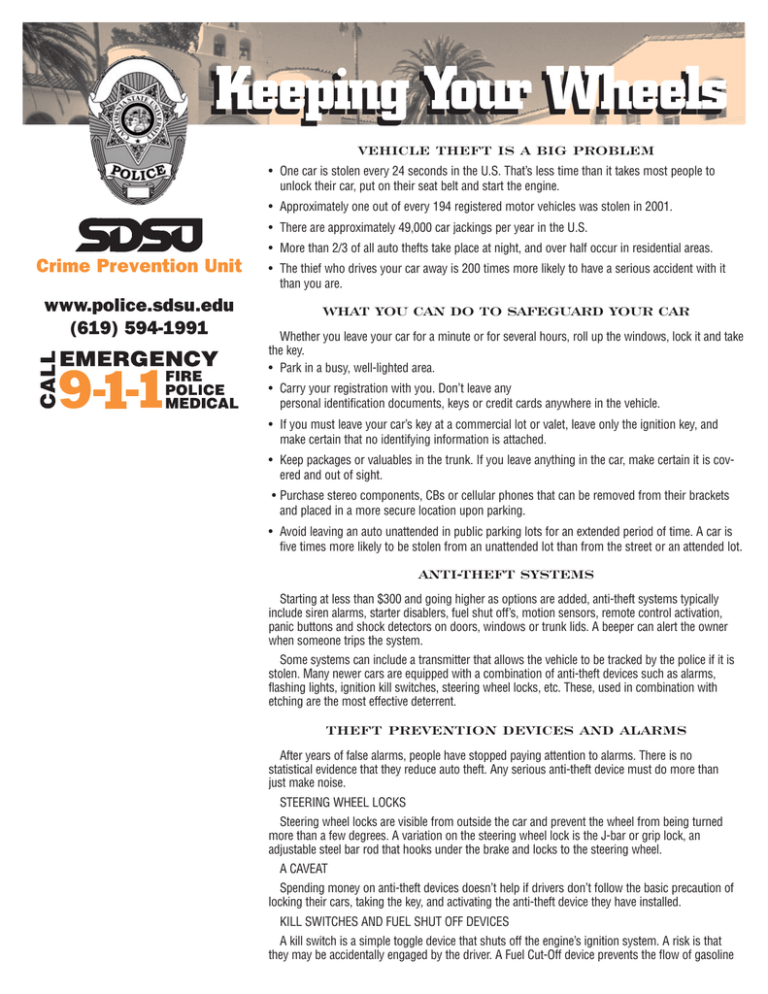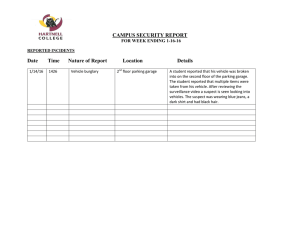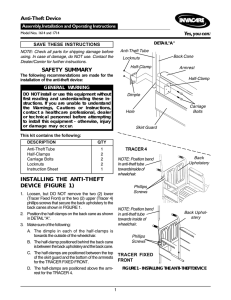Keeping Your Wheels
advertisement

Keeping Your Wheels VEHICLE THEFT IS A BIG PROBLEM • One car is stolen every 24 seconds in the U.S. That’s less time than it takes most people to unlock their car, put on their seat belt and start the engine. • Approximately one out of every 194 registered motor vehicles was stolen in 2001. • There are approximately 49,000 car jackings per year in the U.S. • More than 2/3 of all auto thefts take place at night, and over half occur in residential areas. Crime Prevention Unit www.police.sdsu.edu (619) 594-1991 • The thief who drives your car away is 200 times more likely to have a serious accident with it than you are. WHAT YOU CAN DO TO SAFEGUARD YOUR CAR Whether you leave your car for a minute or for several hours, roll up the windows, lock it and take the key. • Park in a busy, well-lighted area. • Carry your registration with you. Don’t leave any personal identification documents, keys or credit cards anywhere in the vehicle. • If you must leave your car’s key at a commercial lot or valet, leave only the ignition key, and make certain that no identifying information is attached. • Keep packages or valuables in the trunk. If you leave anything in the car, make certain it is covered and out of sight. • Purchase stereo components, CBs or cellular phones that can be removed from their brackets and placed in a more secure location upon parking. • Avoid leaving an auto unattended in public parking lots for an extended period of time. A car is five times more likely to be stolen from an unattended lot than from the street or an attended lot. ANTI-THEFT SYSTEMS Starting at less than $300 and going higher as options are added, anti-theft systems typically include siren alarms, starter disablers, fuel shut off’s, motion sensors, remote control activation, panic buttons and shock detectors on doors, windows or trunk lids. A beeper can alert the owner when someone trips the system. Some systems can include a transmitter that allows the vehicle to be tracked by the police if it is stolen. Many newer cars are equipped with a combination of anti-theft devices such as alarms, flashing lights, ignition kill switches, steering wheel locks, etc. These, used in combination with etching are the most effective deterrent. THEFT PREVENTION DEVICES AND ALARMS After years of false alarms, people have stopped paying attention to alarms. There is no statistical evidence that they reduce auto theft. Any serious anti-theft device must do more than just make noise. STEERING WHEEL LOCKS Steering wheel locks are visible from outside the car and prevent the wheel from being turned more than a few degrees. A variation on the steering wheel lock is the J-bar or grip lock, an adjustable steel bar rod that hooks under the brake and locks to the steering wheel. A CAVEAT Spending money on anti-theft devices doesn’t help if drivers don’t follow the basic precaution of locking their cars, taking the key, and activating the anti-theft device they have installed. KILL SWITCHES AND FUEL SHUT OFF DEVICES A kill switch is a simple toggle device that shuts off the engine’s ignition system. A risk is that they may be accidentally engaged by the driver. A Fuel Cut-Off device prevents the flow of gasoline once the fuel to the gas line is used. Only a special key de-activates the cut-off. Improperly installed switches can damage the electrical systems on newer cars, and possibly void the warranty. COLLARS Collars are devices that prevent the steering column form being stripped. ETCHING PARTS Many cars are stolen for parts. Professional thieves shy away from a vehicle that has had the vehicle identification number (VIN) etched into the doors, windows, windshield, etc. ANTI-THEFT PROGRAMS... Organize a community partnership to raise awareness; install anti-theft devices; start an etching program; CAT or HEAT programs (voluntary registration of cars with the Police so they may stop a vehicle if seen during peak crime hours). Get involved. Report any suspicious persons or behavior to the police immediately. Thieves will commonly “case” the area they intend to steal from first. Crooks shop for cars much like we do, often looking for a specific model or certain equipment. The difference is they don’t intend to pay for theirs. Persons seen loitering around parked cars or driving through parking lots for no apparent reason could be looking for their next vehicle, maybe yours! WHEN YOU BUY A CAR... • Be suspicious if the price is lower than normal. Hot cars are no bargain! • If possible, don’t pay cash. Your check is your receipt that you bought the vehicle. • Verify that the VIN (Vehicle Identification Number) plate is intact and has not been tampered with. Check it against the ownership documents. • Examine the title and registration papers carefully. If you have any doubts, don’t buy. • Knowingly buying a stolen vehicle or even a stolen part is a crime! CARJACKING “Carjacking” is the taking of a motor vehicle from a person or from his or her immediate presence, accomplished by means of force or fear. Here are some tips to reduce the chances of being “carjacked”: GETTING IN • Reduce your chances of being carjacked by walking with purpose, and stay alert. • Approach your car with the key in hand. Look around and inside the car before getting in. GETTING OUT • Park in well-lighted areas, near sidewalks or walkways. Avoid parking near dumpsters, woods, large vans or trucks, or anything else that limits your visibility. • Never leave valuables in plain view even if the car is locked. Put them in the trunk or out of sight. WHEN ON THE ROAD • Keep doors locked and windows rolled up, no matter how short the distance or how safe the area. • Look around, especially at places where you slow down or stop, such as garages and parking lots, intersections, self-serve gas stations and car washes, highway entry and exit ramps, and ATMs. • When coming to a stop, leave enough room to maneuver around other cars, especially if you sense trouble and need to get away. • Avoid driving alone, if possible. Travel with someone, especially at night. • Don’t stop to assist a stranger whose car has broken down. Help instead by driving to the nearest phone and calling police to help. • Always keep your car well maintained, and make sure you have plenty of gas. IF IT HAPPENS TO YOU • If the carjacker threatens you with a gun or other weapon, give up your car. Don’t argue. Your life is worth more than a car. • Get away as quickly as possible. • Contact the police immediately Crime Prevention Unit www.police.sdsu.edu (619) 594-1991


